
| Random files - Stkp's Gallery |
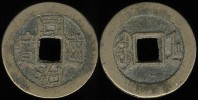
Schjöth 1554, Hartill 26.84 Type 1.3 (QC) & 22.1220 (CCC), KM C 4-17Tongzhi (1862-1874)
1 cash (cast brass), 1862 [?] -1874 [?], Zhejiang Province (in Hangzhou), 23 mm.
Obv: Tongzhi tongbao.
Rev: Boo je.
Type 1.3 is comprised of coins with a square protruding head tong. It is a Coastal Province Type.
Hartill rarity 8 (QC) & 14 (CCC).Stkp
|
|

France (Feudal): Gien (County of Donzy). Geoffrey III (1120-1160) or Herve III (1160-1194).Boudeau 297, Poey d'Avant 1998 (p. 42 no. 21), Duplessy 605, Legros 1565, Roberts 1497-8
AR denier, struck 1120-1191, 19 mm.
Obv: + GOSEDVS COS (Geoffroi, count), cross with staff and hammer in second angle and triangles in other three angles.
Rev: + GIEMIS CA (Castle of Gien), degraded monogram of Fulk of Anjou (legend begins at 9 o’clock).
The deniers of Gien were derived from those of Angers and bear a degraded monogram of Fulk of Angers. The reason for this is unclear as the regions are far apart and there is no connection between them. Standards of weight and fineness appear to have been similar, as records from 1202-3 value the denier giennois at 1.5 deniers parisis and the denier angevin at 1.46 d.p.
The deniers are struck in the name of a Count Geoffrey, and the type may have begun under Geoffrey II (1169-1184) or more probably Geoffrey III (1120-1160), but was immobilized after 1160. The coin is variously attributed to either or both of them, and also to Herve III (1160-1194). It ceased to be minted in 1191 when King Phillip II Augustus (1180-1223) acquired Gien and closed its mint.Stkp
|
|
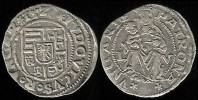
Huszár 841, Pohl 255-33, Unger 673ζ, Réthy II 306A, dated 1526 Hungary. Louis II (Lajos II in Hun.) (1516-1526). AR denar, 15 mm.
Obv: LVDOVICVS â—¦ R â—¦ VNGAR * 1526 *, Four-part shield with Hungarian arms (Árpádian stripes, patriarchal cross, Dalmatian leopard heads, Bohemian lion), Polish eagle in escutcheon.
Rev: PATRONA * – * VNGARIE, Crowned Madonna with infant Jesus to her right, L–V (privy mark) in fields.
The type was struck 1516-1527 (per Huszár, Pohl & Unger). This privy mark was struck in Visegrád and was a posthumous issue of Louis II (per Pohl). Louis II died on August 29, 1526 when he drowned while fleeing from the Turks after the carnage of the battle of Mohács.
Huszár/Pohl rarity rating 3.
Stkp
|
|
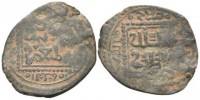
Ayyubid. Branch at Halab/Aleppo. al-Nasir Yusuf II (Emir of Syria, 634-658 A.H. = 1236-1260 A.D.)Album 845; Balog 760
AE fals; Halab/Aleppo mint, dated 655 A.H. = A.D. per Balog but undated per Album: 2.53 g., 24.61 mm. max., 180°
Obv.: Circular line border in a dotted circle, within which there is a square in dotted square; border segment inscription and al-Malik / al-Nasir in center.
Rev.: Circular line border in a dotted circle, within which there is a square in dotted square; border segment inscription and al-Imam / al-Musta'sim in center.
Attribution courtesy of newcoins and legends courtesy of mazdaro.Stkp
|
|
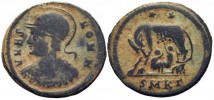
Urbs Roma CyzicusRIC VII Cyzicus 90
Cyzicus mint, third officina, struck under Constantine I, 330-333 A.D.
AE3, 2.31 g., 18.56 mm. max., 180°
Obv: VRBS ROMA, helmeted bust of Roma left, wearing imperial cloak.
Rev: She-wolf standing left, suckling the twins (Romulus and Remus), two stars above, SMKΓ in exergue.
RIC rarity R5Stkp
|
|

Kingdom of Elymais. Arsacid dynasty. Kamnaskires-Orodes (early-mid 2nd century A.D.)van't Haaff 12.3.1-1B; De Morgan 50; BMC plate XLI, 4-9; Sear GICV 5910 (Kamnaskires-Orodes III); Alram --
AE drachm, 3.54 g., 15.38 mm. max.
Obv: Bust facing forward without small hair tuft on top, and large curly hair tufts on each side in horizontally-oriented rows; to right pellet within crescent above anchor with one crossbar at top; pellet border.
Rev: Dashes; no border.
Stkp
|
|

Cilician Armenia. Levon I, the Great (1199-1219)Vardanyan Group D; Nercessian 303 var. (rev. legend), Bedoukian 746 var. (rev. legend, per 737)
AE tank. Sis (now Kozan, Turkey) mint. 7.14 g., 29.63 mm. max., 180°
Obv: + ԼԵՒՈՆ ԹԱԳԱՒՈՐ ՀԱՅՒՈ (= Lewon Tagawor Haywots = Levon, King of Armenians), leonine head of the king, six dots on the crown, pendilium and hair represented by vertical row of three large dots; and the mane/beard by an irregular juxtaposition of smaller dots.
Rev: + ՇԻՆՍԼ Ի ՔԱՂՍՔՍ Ի ՍԻՍ [Type 4 letter Ք] (= Shineal i kaghakn i Sis = Struck in the city of Sis), patriarchal cross with six-pointed star on each side.
The sequence of issuance of the four groups is unknown.Stkp
|
|

Vietnam. Lê Kings Under the Trįn. Cánh Hųng (1740-1786). Cánh Hųng Chính BảoBarker 70.1; Toda 117; Zeno # 312937
Bronze 1 van; 2.71 g., 24.43 mm. max.
Obv: 景興正寶 Cánh Hųng Chính Bảo (Legal Currency)
Rev: plain
Barker rarity 5Stkp
|
|

Elymais. Arsacid dynasty. Orodes IV (ca. 2nd half of 2nd century A.D.)van't Haaff 17.2.1-1; de Morgan 54; BMC plate XLII, 2; Sear GICV 5914; Alram --
AE drachm, 3.11 g., 14.12 mm. max., 0°
Obv: Bust facing forward, wearing diadem band, with large hair tuft on top and sides of head; pellet border.
Rev: Bust of Artemis facing left, wearing low tiara with crest of dots; to right, anchor with one crossbar on top; pellet border.Stkp
|
|

Schjöth 1466 var., Hartill 6.77 Type H2 (QC) & 22.266 (CCC), KM 391Qianlong (1736-1795)
1 cash (cast brass), 1796 -1799 [?], Board of Works mint (in Beijing), new branch, 25 mm.
Obv: Qianlong tongbao.
Rev: Boo yuwan.
The Shanlongs (Type H) were cast during the period in which Qianlong had officially abdicated in favor of Jiaqing, but was still ruling as the Great Super Emperor (1796-1800). The type is comprised of coins with a special form of long and a six stroke, open bei. The Type H2 coins are of good size and workmanship. The Z yi is written with curved lines, the dots in the tong are verticle and the Y- of yuwan is long and crurved. The coins of the new branch have a closed head tong.
Hartill rarity 9 (QC) & 15 (CCC).Stkp
|
|

Hartill 16.146, Schjöth 514, Fisher’s Ding 993, Gorny 20a-01, Zeno #309732The Northern Song: Emperor Ren Zong (1022-1063)
1 cash/wen (cast bronze); cast 1056-1063; 3.44 g., 23.74 mm. max.
Obv: Jia You yuan bao 嘉祐元寶 (clockwise); seal script, round bei 貝 component of bao 寶.
Rev: Blank
Hartill rarity 15.Stkp
|
|

Hungary. Béla IV (1235-1270). Huszár 302, Toth-Kiss 22.34.1.1, Unger 226, Réthy I 238, Frynas H.18.14, Lengyel 18/12, Adamovszky A363Hungary. Béla IV (1235-1270)
AR obulus (average .27 g., 10.3 mm.); .23 g., 10.32 mm. max. 0°
Obv: Crowned king sitting on throne holding sceptre and orb
Rev: B-E / LA R / EX with lines dividing legend into three rows and five parts
The coins of Béla IV were issued with an average fineness of .800 and “later” .900, per Huszár at 11.
Struck after the Mongol invasion of 1241/1242? per Gyöngyössy
Huszár rarity 10; Toth-Kish 35, Unger value 60 DM, Frynas rarity SStkp
|
|

Huszár 620, Pohl 177-2, Unger 486b, Réthy II 157AHungary. János Hunyadi (Governor, 1446-1453). Billon denar, .31 gr., 15 mm.
Obv: + TE[MPORE IO • ]GVB[ERnATOR], Crowned lion of Berszterce facing left.
Rev: * MOn[ETA • REGn]I • VnGARIE, Patriarchal cross, B–n (privy mark) in fields.
The type was struck in 1447-1450 (per Huszár & Unger) or 1447-1451 (per Pohl). This privy mark was struck in Buda (now Budapest) by Michael Nadler, (per Pohl).
Huszár/Pohl rarity rating 6. The legends described and depicted in Huszár and Pohl differ slightly from those described and depicted in Unger and Réthy. The reverse of this coin comports with Réthy and Unger.Stkp
|
|
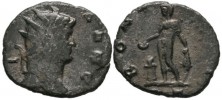
Gallienus (Publius Licinius Egnatius Gallienus) (253-268 A.D.)SRCV 10185 , RIC V S-470 var., Göbl 1391a, Van Meter 27 var.
BI Antoninianus, 1.71 g., 17.67 mm. max., 0°
Mediolanum mint, 3rd officina, struck during joint reign (253-260 A.D.), in 264-265 A.D.
Obv: [GALLIENV]S AVG, radiate head right.
Rev: BON [EVEN AVG], Bonus Eventus, nude, standing facing, head left, sacrificing from patera in right hand over lit altar, corn ears in left. MT in exergue.
Bonus Eventus, the god of good outcomes, was originally worshiped by the Romans as a deity especially presiding over agriculture and successful harvests. During the Imperial era, he was associated with other types of success. RIC describes the figure as Genius.
RIC rarity C, Van Meter VB1.Stkp
|
|
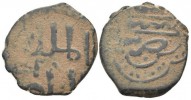
Mamluk (Bahri). Hasan (al-Nasir Nasir al-Din Abu'l-Mahasin) (1st reign, 748-752 A.H. = 1347-1351 A.D.; 2nd reign 755-762 A.H. = 1354-1361 A.D.)Balog (1970) 905B; SNAT Hamah 505-511; Album 947
AE fals, Hamah mint, dated (75)1 A.H. = 1350/51 A.D. (first reign): 2.36 g., 18.72 mm. max., 180°
Obv.: Solid border. الملك / الناصر (= al-malik / al-Násir) in two rows in center.
Rev. Octolobe of dots, solid octolobe within, mint name and date separated by ornamental border in center.
Hasan was the seventh son of Muhammad I to hold office. Upon the death of his half-brother, Sultan Hajji, in 1347, Hasan was raised to the sultanate at age 12 by senior Mamluk emirs formerly belonging to his father. Upon his accession, he disavowed his given (Turkic) name and assumed the Arabic name, Hasan. He was toppled by the emirs in 1351 when he attempted to assert executive authority, and reinstated by them three years later during a coup against his half-brother, Sultan Salih. During his second reign, he pursued a policy of minimizing the role of the mamluk emirs in the state and relying instead on the descendants of mamluks, known as awlad al-nas. Hasan was killed in 1361 at age 27 by one of his own mamluks, who led a faction opposed to Hasan's policy of elevating the awlad al-nas to positions of authority. Hasan was the only descendant of Muhammad to have had a significant impact on events in the sultanate, and was referred to by a Mamluk-era historian as one of the "best kings of the Turks." Stkp
|
|

Julian II, The Apostate (Caesar, 355-360 A.D.; Augustus, 360-363 A.D.) (Flavius Claudius Julianus)RIC VIII Arles 318 var.
AE1 (27 mm), Arles mint, third officina, struck 362 A.D.
Obv: D(ominus) N(oster) FL(avius) CL(audius) IVLI-ANVS P(ius) F(elix) AVG(ustus), bearded, pearl-diademed, draped and cuirassed bust right.
Rev: SECVRITAS REIPVB, Bull standing right, two stars above, to right eagle standing right and holding wreath in beak, TCONST in exergue.
RIC rarity R
The bull has variously been referred to as a sacrificial bull, the Mithraic bull, the Apis bull, and a zodiacal representation of Julian. Most recently, it has been referred to as a solar symbol, representing Julian’s devotion to the god Sol/Helios, the message being “by his appointment of Julian as emperor in particular . . . Sol guarantees the security of his herds, the state.” Shaun Tougher. “Julian’s bull coinage: Kent revisited.” The Classical Quarterly (New Series 2004), 54, pp 327-330 at 327, quoting D. Woods. “Julian, Gallienus, and the Solar Bull.” American Journal of Numismatics, 12 (2000), 157-169, at 168 n.1.
The coin was issued in all mints except for Trier, Rome and Alexandria. The eagle only appears on the coins struck at Arelatum/Constantina. It typically is depicted standing on a wreath. This is a variant in which the eagle does not stand on a wreath. Cf., CNG Electronic Auction 74, Lot 96. Stkp
|
|
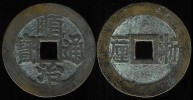
Schjöth 1393, Hartill 26.4 (Type D), KM 278Shunzhi (1644-1661)
One cash, 1653-1657, Zhejiang province (Hangzhou mint), 25 mm.
Cast Bronze (officially 70% copper and 30% zinc, but actually on average 64.9% copper, 23.8% zinc, 7.7% lead, 2.3% tin, etc.), nominal weight 1.25 qian = 4.6625 grams.
Obv: Shunzhi tongbao
Rev: Yi li to the left of the hole, Zhe to the right
Note: At the beginning of the Qing Dynasty the exchange rate was 700 cash to a liang (or tael = .0373 grams) of silver. The authorities tried to maintain a fixed ratio of 1,000 cash to a liang of silver. The yi li (one li = .0373 grams) cash of Shunzhi bears this ratio on the reverse, in a failed attempt to define the rate.
Hartill rarity 8
Stkp
|
|

Elymais. Arsacid dynasty. Orodes V (late 2nd -- early 3rd centuries A.D.)van't Haaff 18.1.1-2A; de Morgan 56-57 ((Orodes IV); BMC plate XLII, 7-8, page 282, 1, 6; Sear GICV 5916-5917; Alram 490
AE drachm, 3.01 g., 13.86 mm. max., 0°
Obv: Bust facing left, diademed, with hair tuft on top of head; anchor; pellet border.
Rev: Bust of Artemis facing left, wearing low tiara with crest of dots; pellet border.Stkp
|
|

Elymais. Arsacid dynasty. Prince A (late 2nd to early 3rd centuries A.D.)van't Haaff 19.1.1-1A; de Morgan 58-59; BMC plate XLII, 13-18, page 286, 18; Sear GICV 5918-5919; Alram --
AE drachm, 2.64 g., 15.19 mm. max., 0°
Obv: Bust facing left, wearing diadem of two bands, row of dots above, side whiskers as double row of dots, hair tuft at back of head; to right anchor with one crossbar; pellet border.
Rev: Artemis standing right, holding bow in one hand, plucking arrow from her quiver with the other hand; two dots to her right; pellet border.
According to van't Haaf, the varieties with a hair tuft are "always" accompanied by a dot or star in crescent above and an anchor to the right, although these symbols are often struck off the flan. The crescent and anchor are present on this coin.Stkp
|
|
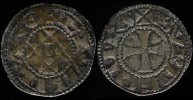
France (Feudal): Dukes of Aquitaine. William X, the “Saint” (1127-1137).Roberts, 4311, Boudeau 464, Poey d'Avant 2735
AR denier, Bordeaux mint, 18 mm.
Obv: + CLVILILMO [first L retrograde] (Guillaume), four crosslets forming a cross.
Rev: + BVRDECIILA (Bordeaux, Burdigalae in Latin), cross pattée.
William X (1099–1137), was Duke of Aquitaine, Duke of Gascony, and Count of Poitou (as William VIII). He was the son of Duke William IX by his second wife, Philippa of Toulouse. He was born in Toulouse when his father was briefly the Count. Shortly after his birth his father went on Crusade, and he was raised in Poitiers by his mother. His father later abandoned her, and took Dangerose, the wife of one of his vassals, as mistress. This caused strain between father and son, until William married Aenor de Châtellerault, daughter of Dangerose, in 1121. They had three children, one of whom was Eleanor of Aquitaine, his heiress.
William was a lover of the arts and a warrior. He became involved in conflicts with Normandy and France. Inside his borders, he faced an alliance of the Lusignans and the Parthenays against him, an issue he resolved by the total destruction of his enemies. William X initially supported antipope Anacletus II in the papal schism of 1130, against the will of his own bishops. In 1134 Saint Bernard of Clairvaux convinced William to drop his support of Anacletus and to embrace Pope Innocent II.
In 1137 William joined the pilgrimage to Santiago de Compostela, but died of suspected food poisoning during the trip. He left the dukedom and the care of his 15-year-old daughter to King Louis VI of France. Louis VI accepted this guardianship and married Eleanor to his son, Louis VII.Stkp
|
|

Huszár 718, Pohl 219-3, Unger 564c, Réthy II 234, Kaplan Subtype A Hungary. Matthias "Corvinus" (Mátyás Hunyadi in Hun.) (1458-1490). AR denar.
Obv: + MOnETA MAThIE • R • VnGAR, Four-part shield with Hungarian arms (Árpádian stripes, patriarchal cross, Dalmatian leopard heads, crowned lion of Berszterce), raven in escutcheon.
Rev: • PATROn – VnGARI •, Veiled Madonna with infant Jesus to her right, K–C (privy mark) in fields.
The type was struck 1471-1481 (per Huszár & Unger) or 1472-1478 (per Pohl), with an average fineness of approximately .500 silver, and an average weight of .59023 g. This privy mark was struck in Kremnitz (formerly Körmöcbánya, Hungary, now Kremnica, Slovakia) by Johannes Constorfer, kammergraf (per Pohl).
Huszár/Pohl rarity rating 4. This is a variable type with two subtypes. Subtype A is the more common, comprising around 80% of the coins of the emission. This privy mark appears on almost 30% of the coins of this type.
In Subtype A coins, the obverse legend is + MOnETA • MAThIE • R • VnGARIE (or a minor variant). They are described and/or depicted in all of the catalogs.
Stkp
|
|

Hungary. Béla III (1172-1196). Huszár 72; Toth-Kiss 16.5 var. sigla 0.1/1; Unger 114; Réthy I 98-100; Frynas H.15.24; Lengyel 15/27; Adamovszky A223 ff.Hungary. Béla III (1172-1196)
AE denomination unknown (average: 2.88 g., 22.5-27.5 mm.), 3.10 g., 26.41 mm. max., 270°
Obv (concave): REX BELA (on left, running counterclockwise)-REX STS (on right, running clockwise), Two kings seated on thrones facing, each holding scepter and globus cruciger; long cross between. Inverted crescent and three lines in exergue.
Rev (convex): SANCTA-MARIA, Nimbate Madonna facing the front, scepter in right hand, infant Jesus in left. Two crosses above.
Struck in Esztergom. Struck 1172-1182 (per Gyöngyössy, whose dating has not been accepted by later catalogers and appears to be speculative).
Note: “The financially unsuccessful attempt at minting copper coins was carried out exactly as its prototype, the Byzantine coppers. On these copper coins the stiff representation of the two royal figures recalls Byzantine icons, and the symmetry prevailing in the design creates a favorable impression. This direct adoption of the Byzantine model, as well as the whole attempt at coining copper money, may be ascribed to the fact that King Béla III spent a long period of time at the Byzantine court” (Huszár 1963, at 9-10).
Huszár rarity 1, Toth-Kiss rarity 20, Unger rarity 8, Frynas rarity C. Unrecorded variety with unusual ELA in BELA and retrograde first S in STS, as confirmed by József Géza Kiss via personal email communication on December 14, 2018.Stkp
|
|

Italian States. Venice. Grosso. Francesco DandoloCNI VII 16; Papadopoli 4.1; Paolucci _; Biaggi _
AR Grosso (0.965 fineness; 2.178 g.), struck under 52nd Dodge Francesco Dandolo (1328-1339); 2.06 g., 19.79 mm. max., 180°
Obv.: • FRA • DANDVLO [•] - • S • M • VENETI, Doge and St. Mark standing facing, holding banner between them, D / V / X in center.
Rev.: Barred IC-XC across field, Christ enthroned facing.Stkp
|
|

Hartill 16.155, Schjöth 517, Gorny 21b-09, Zeno #309760The Northern Song: Emperor Ren Zong (1022-1063)
1 cash/wen (cast bronze); cast 1056-1063; 3.67 g., 24.77 mm. max.
Obv: Jia You tong bao 嘉祐通寶; true orthodox script, large Jia 嘉.
Rev: Blank
Hartill rarity 15.Stkp
|
|

Huszár 584, Pohl 123-4, Unger 455d, Réthy II 128, Frynas H.27.12Hungary. Sigismund/Zsigmond of Luxembourg (1387-1437; Holy Roman Emperor 1433-1437)
AR ducat (= 1/4 denar; average fineness .181‰; average weight .22 g.); .34 g., 11.16 mm. max,. 180°
Obv: Patriarchal cross, K-C [retrograde] between arms.
Rev: Standing nimbate St. Ladislaus with halberd and globus cruciger.
The type was struck in 1427-1430 (per Huszár, Pohl, Unger, Frynas and Gyöngyössy). This privy mark is a civic mark struck in Kremnitz/Körmöcbánya, now Kremnica, Slovakia (per Pohl).
Huszár/Pohl rarity 4; Frynas rarity C.
Stkp
|
|
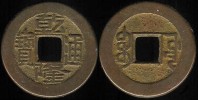
Schjöth 1466, Hartill 6.69 Type F2, KM 390Qianlong (1736-1795)
1 cash (cast brass), 1775 [?]-1794 [?], Board of Works mint (in Beijing), new branch, 23 mm.
Obv: Qianlong tongbao.
Rev: Boo yuwan.
Type F coins have a Z yi, the Y- of yuwan is horizontal, a slanting gan, and a diameter around 23 mm. Type F2 coins have a protruding head boo. The coins issued by the new branch have a closed head tong.
Hartill rarity 11Stkp
|
|

Alawi Sharifs (Morocco). Sidi Mohammed IV (1859-1873)KM C 166.1, Eustache __, Valentine --
Cast Bronze, 4 fallus dated 1288/7 A.H. = 1871 A.D., Fes mint, 28 mm.
Obv: Seal of Solomon.
Rev: Mint name (Fes) and date (1288/7) within two circles.
Stkp
|
|
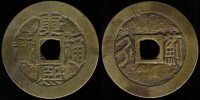
Schjöth 1431, Hartill 27.64-65 Type 1, KM 326Kangxi (1662-1722)
1 cash (cast brass), 1667-1670, Zhili province (Jizhou mint), 27.5 mm.
Obv: Kangxi tongbao.
Rev: Gi (in Manchurian) to the left, ji (in Chinese) to the right.
Type 1 (the only type at this mint issued by Kangxi) is comprised of coins with a nominal weight of 1.4 qian (= 5.22 grams).
This is one of a series of twenty coins known as “poem” coins (shi qian), which, according to folklore, have talismanic qualities when placed together. The coins were put in a specific order in which the mint names formed a “poem.” The poem did not have a particular meaning, but rhymed according to the rules of classical Chinese poetry.
Hartill rarity 8Stkp
|
|

Italian States: Norman Sicily. Roger II (1105-1154)Travaini 243; Spahr 80; MEC Italy XIV 217-220a.
AE Follaro, fifth period. Messina mint, 1141-1142. 1.14 g., 14.24 mm. max.
Obv: bi-'l–amri 'l-malakī (= by the order of the king was minted) in Kufic script.
Rev: Cross: around margin: Was minted in Messina (Māsīnī) the year six and thirty and five hundred (in Kufic script).
Roger II was the younger son of Count Roger I. Upon the death of his elder brother, Simon, in 1105, Roger became Count of Sicily under the regency of his mother, Adelaide del Vasto. As reward for his support for Roger supported Antipope Anacletus II against Pope Innocent II, Roger was crowned by Anacletus in 1130. After the death of Anacletus, Innocent invaded Sicily in 1139 but was captured. Three days later, he recognized Roger as king.Stkp
|
|

Gallienus (Publius Licinius Egnatius Gallienus) (253-268 A.D.)SRCV 10224, RIC V J-18, Göbl 872d, Cohen 308, Van Meter 316
AR Antoninianus, 19-21 mm., 180°
Cologne mint (per Göbl), struck during joint reign with Valerian (253-260 A.D.) in 259 A.D.
Obv: GALLIENVS P F AVG, Radiate cuirassed bust right.
Rev: GERMANICVS MAX V, Trophy between two German captives.
Commemorates Gallienus’s victory over the Alemanni at the Battle of Mediolanum (Milan) in 259 A.D. (per Van Meter), which is inconsistent with the slightly earlier dating per RIC (258-259 A.D.) and Göbl (apparently 257-258 A.D.).
RIC rarity C, Van Meter VB2Stkp
|
|

Huszár 580, Pohl 119-64, Unger 451ii, Réthy II 125AHungary. Sigismund (Zsigmond, in Hun.) of Luxembourg (1387-1437; Holy Roman Emperor 1433-1437). AR parvus, 10.5 mm.
Obv: Four-part shield (Árpádian stripes and eagle), S—V—R above and flanking, T-O flanking the S (privy mark).
Rev: Cross with four crowns between its arms.
The type was struck in 1387-1427 (per Pohl, Huszár & Unger, although this emission terminated in 1410 per Engel).
Huszár/Pohl rarity rating 4.
The parvus (also called the “small denar” fillér or pankart) was struck with an average nominal fineness of 0.353 silver. Because of many worn out and counterfeit coins it was pulled from circulation after 1427 (per Huszár). Although not specifically discussed in this context in Engel, the parvus must have experienced the same rampant debasement as the denar did.
“Owing to inner strife and disordered general conditions, the coins [of this period] were usually minted with extremely low precious metal content; moreover, poor mintages were often struck with negligently engraved dies. As a result of the hurried, superficial minting, it was sometimes doubtful whether a faulty coin had been issued officially, or was a forgery” (Huszár 1963, at 15). This emission is typically struck on a small flan.
Stkp
|
|
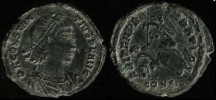
Constantius II (Ceaesar, 324-337 A.D.; Augustus 337-361 A.D.) (Flavius Julius Constantius)RIC VIII Constantinople 121
Constantinople mint, 2nd officina, struck 348-358 A.D.
AE3 Half Centenionalis , 17-18 mm., die orientation 180°
Obv: DN CONSTAN—TIVS PF AVG, pearl-diademed, draped, cuirassed bust right.
Rev: FEL TEMP RE—PARATIO, Roman soldier spearing fallen horseman with brimmed helmet, reaching, CONSB in exergue.
Stkp
|
|
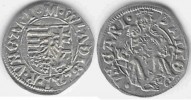
Huszár 807, Pohl 242-1, Unger 641a, Réthy II 272B. Kaplan Subtype A (pub. pending)Hungary. Wladislaus II (Ulászló II in Hun.) (1490-1516). AR denar, 16 mm.
Obv: M • WLADISLAI •R • VNGARI •, Four-part shield with Hungarian arms (Árpádian stripes, patriarchal cross, Dalmatian leopard heads, Bohemian lion), Polish eagle with outstretched wings in center.
Rev: PATRON • — • VNGARI •, Crowned Madonna with infant Jesus to her right, K—h (privy mark) in fields.
The type was struck 1498-1503 (per Unger) or 1500-1502, except for one rare mint mark that was struck ca. 1505 (per Pohl). This privy mark was struck in Kremnitz (formerly Körmöcbánya, Hungary, now Kremnica, Slovakia) by Hans Thurzó (per Pohl).
Huszar/Pohl rarity rating 3. Subtype A is the form of the emission, in which the bottom of the Madonna’s robe has a single distinctive fold in its center (depicted in Huszár and Pohl, but not described in Huszár, the text of which is erroneous in its description of the Madonna on this emission)
Stkp
|
|

Elymais. Arsacid dynasty. Orodes II (early-mid 2nd century A.D.)van't Haaff 13.3.2-2A; De Morgan 46; BMC plate XL, 13; Sear GICV 5905; Alram --
AE drachm, 4.10 g., 14.49 mm. max.
Obv: Bust facing forward, wearing tiara without crest with central vertical line and dots at rim, two diadem bands below tiara with row of pearls; to right star within crescent above anchor with one crossbar at top; pellet border.
Rev: Dashes with regular pattern; no border.Stkp
|
|

Schjöth 1489, Hartill (QC) 5.167 Type C2, KM 440.1Jiaqing (1796-1820)
1 cash (cast brass), 1816 [?] – 1820 [?], Board of Revenue mint (in Beijing), west branch, 24 mm.
Obv: Jiaqing tongbao.
Rev: Boo chiowan.
Type C is comprised of coins in which the top stroke of bao is a distinct dot. The bei is squarish, with feet as distinct strokes at the corners (except for the coins cast at the east branch of the mint). The size is variable. Type C2 coins are comprised of those with a straight left-hand stroke of the qing. The west branch of the mint cast coins with a closed head, one dot tong.
Hartill rarity 11Stkp
|
|

Anonymous 12th Century Class II. Huszár 117a; Toth-Kiss 19.7.1.1 sigla a2.2/34; Unger 82; Réthy I 129; Frynas H.14.5; Lengyel 14/53; Adamovszky A124a Huszár 117a; Toth-Kiss 19.7.1.1 sigla a2.2/34; Unger 82; Réthy I 129; Frynas H.14.5; Lengyel 14/53; Adamovszky A124a
Hungary. Anonymous 12th Century Class II; attributed to István/Stephen III (1162-1172) by Lengyel and tentatively attributed to him by Unger, Frynas and to Géza II (1141-1162) per Adamovsky, but these attributions are not accepted by Huszár, Toth-Kiss and Gyöngyössy.
AR denar (average: .20 g., 13 mm.), .27 g., 13.25 mm. max.
Obv: Cross with three wedges at the ends and H's between the angles.
Rev: Cross with pellets at the ends.
Struck in Esztergom.
Huszár rarity 8, Toth-Kiss rarity 50, Unger rarity 50, Frynas rarity N.Stkp
|
|

Crusader States: Principality of Antioch. Bohemond III (1163-1201)Metcalf Class C 388-391; Malloy 65-67
Billon Denier, struck circa 1163-1188, 18 mm
Obv: +BOANVNDVS [A ornamented with annulets, retrograde N’s], helmeted and mailed head left, crescent and star on either side.
Rev: +ANTIOCNIA [A’s ornamented with annulets, retrograde N’s], cross pattée, crescent in second quarter.
The Principality of Antioch was a crusader state created in 1098 during the First Crusade by Normans from Italy. In 1268, Baibars, the Mamluk Sultan of Egypt, took the city.
Bohemond (1144–1201), the “Stammerer” or the “Stutterer,” was the son of Constance of Antioch, the daughter of Bohemond II, by her first husband Raymond II of Poitiers, who was killed at the Battle of Inab in 1149 toward the end of the Second Crusade. She ruled as regent from 1149 until 1163, when Bohemond, with the assistance of King Baldwin III of Jerusalem, forced her to step down.
In 1164, Bohemond was captured by Nur ad-Din Zengi, who ruled the Syrian province of the Seljuk Empire, at the Battle of Harim. He was freed for a large ransom due to the intervention of King Amalric I of Jerusalem and Emperor Manuel I Comnenus. In 1192, after the fall of the Kingdom of Jerusalem following the battle of Hattin, Bohemond signed a truce with Saladin. Due to the truce, he remained neutral during the Third Crusade.
Bohemond clashed with Levon I of Armenia, who aspired to expand his kingdom. He was captured by Levon and forced to cede the Principality to Levon. However, the Antiochenes named Bohemond’s eldest son, Raymond IV of Tripoli, as their prince. Bohemond and Levon ultimately reconciled, and Raymond married Levon’s neice, Alice, who died shortly after giving birth to their son, Raymond-Roupen. Bohemond died in 1201 and the succession was disputed between his second son, Bohemond IV, and his grandson, Raymond-Roupen.Stkp
|
|

Sultanate of Palembang Darussalam; Sultan Muhammad Bahauddin (1776–1803)Robinson 9.1 var. (no pellets); Millies 192 var.; Zeno # 280675
Tin piti dated 1203 A.H. = 1789 (minted under Sultan Muhammad Bahauddin [1776–1803]); .61 g., 18.79 mm. max.
Obv.: Al-sultan fi bilad Palembang sanat 1203 (= The sultan of Palembang year 1203)
Rev. Blank
Robinson rarity R1, but variety without pellets not listed in Robinson.Stkp
|
|

Huszár 584, Pohl 123-10, Unger 455k, Réthy II 128, Frynas H.27.12Hungary. Sigismund/Zsigmond of Luxembourg (1387-1437; Holy Roman Emperor 1433-1437)
AR ducat (= 1/10 denar); .31 g., 11.27 mm. max., 0°
Obv: Patriarchal cross, n-S between arms.
Rev: Standing nimbate St. Ladislaus with halberd and globus cruciger.
The type was struck in 1427-1430 (per Huszár, Pohl, Unger, Frynas and Gyöngyössy). This privy mark is a civic mark struck in Nagybánya/now Baia Mare, Romania (per Pohl).
Huszár/Pohl rarity 4; Frynas rarity C.Stkp
|
|

Huszár 457 var., Pohl 14 var., Unger 395 var., Réthy II --, Frynas 24.50 var., Lengyel 24/45/1, Toth 1.32.1.1 var.Hungary. Károly Róbert/Charles Robert (1307-1342).
AR obulus per Huszár, Pohl, Unger, Toth and Lengyel; .35 g., 11.59 mm. (clipped), 180°
Obv: + [M RE]GIS KAROLI ⁘, Shield with Árpádian stripes and Angevin lilies.
Rev: Patriarchal cross on top of base, inward-facing crowned heads and inward-facing birds above them, lilies between cross arms, star to left and crescent with pellet to right.
Issued in 1324 per Huszár, Pohl, Unger and Frynas, or in 1323-1333 per Lengyel; pattern for banaldenár per Pohl.
Huszár/Pohl rarity 10, Unger rarity R, Frynas rarity R. Only Lengyel records a variety with a ⁘ at the end of the obverse legend.Stkp
|
|

Isle of ManMackay 47; Pridmore 29; KM 3a
AE/copper ½ penny; Second Derby Coinage, issued by James Stanley, 10th Earl of Derby (1702-1736), and struck at Castleton by Amos Topping and Charles Dyall of London between January 15, 1733 and March 23, 1734. 5.18 g., 24.04 mm. max., 180°
Obv: SANS • CHANGER [without changing], Stanley family crest of eagle over child in wicker basket, above the cap of maintenance, 1733 below.
Rev: QUOCUNQUE • IECERIS • STABIT [whithersoever you throw it, it will stand] triskeles in center, I-D-½ [Iacobus Darbiensis 1/2 Penny] between legs.
The Second Derby Coinage is comprised of two distinct issues, with this coin coming from the second issue. The metal came from some old brass cannons at Castle Rushen ans is usually referred to as Bath metal. It is a low-grade tin-bronze (copper 97.6; tin 2.2; iron .04; traces of zinc). There were 60,000 minted.Stkp
|
|

Japan. Tokugawa Shogunate. Shin-Kanei Tsuho (new Kanei Tsuho). Yottsuho-senHartill 4.09-13 var. esp. 4.109; Jones (2007) 208-9 var. esp. 208; KM C 1.1 var; Zeno # 254089
1 mon (cast copper alloy), cast from 1708-1712 (Hoei 5 - Shotoku 2), Kameido-mura Edo mint (Musashi Province); 3.11 g., 23.33 mm. max.
Obv: 寛永通寶 Kanei tsuho.
Rev: Blank
There are at least nine varieties of Yottsuho-hen, but Hartill only lists five and Jones only lists two. They are characterized by the hook on the right arm of 永 ei. This variety is called 広永 Ko-ei (wide ei). It is characterized by a wide ei in which the left leg and right arm are long.
Formally called Hōei Kameido-sen, but popularly called Yottsuhō-sen (literally translated as The Four Treasures Coin) because they were small light and badly cast, and hence derogatorily designated Yottsuho-sen, meaning "Poor Coin."
Hartill rarity VCStkp
|
|

Schjöth 1600, Hartill (QC) 5.284 & 22.1129 var. (size) (CCC), KM C 1-15.1Tongzhi (1862-1874)
10 cash (cast brass), 1862-1874, Board of Revenue mint (in Beijing), east branch, 24 mm.
Obv: Tongzhi zhongbao.
Rev: Boo chiowan left and right, dang shi (value ten) top and bottom.
Type A (the Xianfent Type M2) is the only type cast for 10 cash coins. It is a very variable in size and workmanship. This is a smaller degenerate specimen, but the mint branch is nevertheless discernable. It corresponds to Hartill (QC) 5.275, as the fou bao is discernable and it has a six stroke bei.
Hartill (QC) rarity 9 and (CCC) 14.Stkp
|
|

Gallienus (Publius Licinius Egnatius Gallienus) (253-268 A.D.)SRCV 10310, RIC V-S 507, Göbl 1262f, Van Meter 207.
BI Antoninianus, 3.61 g., 22.55 mm. max., 0°
Milan mint, first officina, struck during solo reign (260-268 A.D.), in 264-266 A.D.
Obv: GALLIENVS AVG, radiate head right.
Rev: PIETAS AVG, Pietas standing left, drapery flowing from left elbow, right hand raised over fire altar to left, P in right field.
RIC rarity C, Van Meter VB1.Stkp
|
|

Huszár 569 var., Pohl 114-8 var., Unger 443h var., Réthy II 116 var., Frynas H.26.4 var., Rupp 42/4-6 var. (legend and privy mark) Plate XV/430, Toma Exceptional Version A Hungary. Maria/Mária (1382-1387 solo reign; 1387-1395 with husband Sigismund/Zsigmond of Luxembourg)
AR denar, .54 g., 14.36 mm. max., 0°
Obv: + REGIn... VnGARIE [Gothic-style letter A], Open crown with K below
Rev: + mOnETA • mARIE [Gothic-style letters A; letter T stylized to resemble a letter m], Patriarchal cross
As both sides of the standard Huszár 569 carry a titular legend, there is no consensus regarding obverse and reverse. The fullest legend on the side identified by Huszár and Pohl as the obverse (the side with the crown) is + mARIE D G R VnGARIE (although most coins are missing at least the first G). The fullest legend on the side identified by Unger, Réthy, Frynas and Gyöngyössy as the obverse (the side with the patriarchal cross) is + mOnETA mARIE R V. Since the letters R V are so often omitted from the cross side, Toma accepts the crown side as the obverse.
The standard Huszár 569 was struck in 1384-1395 (per Huszár, with Unger and Frynas agreeing that it incepted in 1384) or in 1385-1395 (per Pohl), and is traditionally viewed as the last of three denarii struck by Maria. More recently, it has been viewed as the second type struck by her (after Huszár 565 and before Huszár 566), in 1383-1385 (per Gyöngyössi and Toma). This coin, with a letter K below the crown, was struck in Körmöcbánya/Kremnitz (now Kremnica, Slovakia) in 1386-1395 (per Pohl).
The letter T on the reverse of this coin is stylized to resemble the letter m. Toma notes that this style of letter T appears on the coins of this type struck at Körmöcbánya, but this apparently occurs only on those bearing the this privy mark (Pohl 114-8) and not on those bearing the Cm mark (Pohl 114-2).
Toma notes fifteen legend variations among 45 coins of the standard type within the Cluj-Mănăştur Hoard, found in Cluj-Napoca, Romania (formerly, Kolozsvár, Hungary), in 1934. They differ mainly in terms of completeness of legends, spelling of the queen's name, presence of pellets, and the styles of the letter A. Toma lists two variations among five coins with a Cm mark (Pohl 114-4).
Toma further notes four versions of the crown and four versions of the patriarchal cross on the standard type. There are six obverse/reverse design combinations appearing among 41 coins in the hoard, one of which, Toma A/b, appears on the single coin with this mark (Pohl 114-8). The design combination on this coin appears to be Toma A/b.
Huszár/Pohl rarity rating 5. This coin is a variation of the type not described/depicted in Huszár and Pohl, Unger and Réthy, or Frynas. It is also not included in Toma's tabulation of legend variations or design combinations. It was recorded by Rupp with the K mark (Pohl 114-8) and viewed by Unger (1974) to be a distinct type, although it is not included in his catalog. Toma notes 16 coins of this variation in the hoard, bearing four privy marks, three with this mark, one which may bear this legend combinations. Toma refers to the side with the patriarchal cross as the obverse, and notes that the design and legend are as per the obverse of Huszár 566. Toma refers to the side with the crown as the reverse, and notes that legend is as per the reverse legend of Huszár 566 but that the design is as per the obverse of Huszár 569. Toma concludes that this variation represents a distinct type, chronologically sandwiched between the earlier Huszár 569 and later Huszár 566.Stkp
|
|
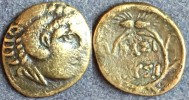
Kingdom of Thrace. Lysimachos (323-281 B.C.)Sear 6822; Müller pl. XLII, 14; SNG Copenhagen 1168-1169.
AE unit, Kallatis (now Mangalia, Romania) mint, ca. 297-281 B.C. or Lysimacheia (now Eksemil, Turkey) mint, 1.15 g., 14.13 mm. max., 0°
Obv.: Head of young Herakles right, wearing lion skin headdress.
Rev.: BAΣI / ΛYΣI in two lines within a wreath of grain.
Lysimachus, one of Alexander the Great's personal bodyguards, was appointed strategos in Thrace and the Chersonesos after Alexander's death. In 309 B.C. he founded his capital Lysimacheia and in 306 B.C. he followed the example of Antigonus in taking the title of king, ruling Thrace, Asia Minor and Macedonia. In 281 B.C. he was killed in battle against Seleucus.Stkp
|
|

Hartill 14.1, Schjoth 312 ffTang Dynasty: Kai Yuan (Early Type, 621-718)
1 cash (cast bronze), nominal weight 1 to 1.1 qian (= 3.73 to 4.103 g.), 2.23 g., 23.70 mm.
Obv: Kai Yuan tong bao
Rev: Blank
The Kai Yuan was the main coin issued by the Tang. It was cast for most of the dynasty, nearly 300 years. It was first issued by the Emperor Gao Zu in the Autumn of the fourth year of the Wu De Period (August 621). This early type is known as the Wu De Kai Yuan. The inscription Kai Yuan tong bao (the Inaugural Currency) is the first to include the phrase tong bao. The Kai Yuan became the prototype for subsequent Chinese coinage.
Hartill rarity 14
ex Forvm Ancient Coins
Stkp
|
|

Domitian (Titus Flavius Domitianus) (Caesar, 69-81 A.D.; Augustus, 81-96 A.D.)RIC II (Titus) 170c
AE As (25 mm), Rome mint, struck 80-81 A.D., under Titus.
Obv: CAES DIVI AVG VESP F DOMITIAN COS VII, laureate head right.
Rev: Minerva advancing right, brandishing javelin and holding shield, S-C surrounding.
RIC rarity C
From an uncleaned coin lot.Stkp
|
|

Denmark. Christian VII (1766-1808) Altona Type 7G, reverse/obverse die combination A784/AO775Altona Type 7G, reverse/obverse die combination A784/AO775 (very common = 100-200 coins); Hede 37, Schou 9-21, Sieg 2, Pedersen __, KM 616.1
1 Skilling, copper (11.693 g.). Altona mint (in Royal Holstein-Schleswig); immobilized date 1771 but minted from mid-1784 to July 1785. Dies made by Johan Henrik Wolff.
11.57 g., 30.01 mm. max., 0°
Obv.: Crowned double C7 monogram.
Rev.: 1 flanked by rosettes / SKILLING / DANSKE / K • M • / 1771 • / rosette, in six lines.
Of the 54,757,104 1771-dated 1 skilling coins minted over a period of 16 years (1771-1786), an estimated 30,000 to 50,000 exist. There are 984 known die combinations. They were minted at three mints. Altona Type 7 comprises 22.1% of the total.Stkp
|
|

Tye 377.1, Deyell 308+, G&G D59.Sultans of Delhi, Shams-al-din Iltutmish (1210-1236 A.D. = 607-633 A.H.). Billon jital of the Lahore type (tentative average silver content 16%), Lahore mint; 3.50 g. (average weight 3.6 g.), 14.26 mm.max., 3.21 mm. thickness, 0◦.
Obv: Horseman bearing lance facing right, star in center, Sri Hamirah (in Nagari script).
Rev: Shams / al-dunya wa'l din / iltutmish / al-sultan (in Arabic script).
Tye rarity rating Common.
Shams-al-din Iltutmish was the second ruler of the Mamluk/Slave dynasty and founder of the Delhi Sultanate. The early Ghorid rulers had maintained a coinage system based on the bull-and horseman coins in place at the Delhi mint. In response to the lack of silver, Iltutmish introduced a bimetallic coinage system consisting of the silver tanka and the billon jital.Stkp
|
|

Anonymous 12th Century Class II. Huszár 124; Toth-Kiss 19.10.1.1 sigla a1b2/91-92; Unger 71; Réthy I 133; Frynas H.12.17; Lengyel 12/10; Adamovszky A133Anonymous 12th Century Class II; attributed to Géza II (1141-1162) by Lengyel and tentatively attributed to him by Unger, Frynas and Adamovsky, but this attribution is not accepted by Huszár, Toth-Kiss and Gyöngyössy.
AR denar (average: .20 g., 11.5-12.0 mm.), .14 g., 11.74 mm. max.
Obv: Horizontal line between wedges, wedges flanked by pellets above and below in center, two letters E with two pellets above and below line (the Es on the right in retrograde), crosses above and below.
Rev: Cross with pellets between arms.
Struck in Esztergom.
Huszár rarity 9, Toth-Kiss rarity 40, Unger rarity 15, Frynas rarity C. Number for unrecorded sigla assigned by József Géza Kiss via personal email communication on January 5, 2019.Stkp
|
|
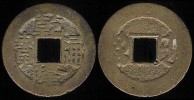
Schjöth 1482, Hartill 16.23 Type 3.3 (QC) & 22.307 (CCC), KM 423Qianlong (1736-1795)
1 cash (cast brass), 1764 [?] – 1794 [?], Hunan Province (in Changsha), 24 mm.
Obv: Qianlong tongbao.
Rev: Boo nan.
Type 3 is comprised of coins with a square head tong, and a protruding head boo. Type 3.3 coins have a small nan.
Hartill rarity 10 (QC) & 16 (CCC).Stkp
|
|

Hungary. Károly Róbert/Charles Robert (1307-1342). Huszár 495 var., Pohl 52-8 var., Unger 393f var., Réthy II 18 var., Frynas 24.46, Lengyel 24/67/7 var., Toth 1.66.1.4 var. [engraving error]Hungary. Károly Róbert/Charles Robert (1307-1342).
AR denár (nominally 0.6687 g.); .59 g., 15.41 mm., 180°
Obv: REGIS • KAROLI, Crowned half-length portrait facing with scepter and imperial orb.
Rev: + • m • REGIS • hVnGARIE, Shield with Árpádian stripes and Anjevin lilies, B-V to left and right engraved over V-B
Issued in 1338 per Huszár, Pohl, Unger, Frynas and Gyöngyössy, or in 1338-1342 per Lengyel, at Buda/now Budapest per Pohl, Lengyel and Gyöngyössy, by Nicolaus Szatmári per Pohl.
Huszár/Pohl rarity 5, Unger value 12 DM, Frynas rarity N. Huszár/Pohl rarity 5, Unger value 12 DM, Frynas rarity N. According to Réthy and Unger, there is no pellet between the cross and the letter m on the reverse. According to Lengyel, there is a pellet there. While Frynas and Toth describe the legend as lacking the pellet, the coin depicted shows the presence of the pellet. Huszár describes the coin as lacking a pellet, and the coin depicted in Huszár and Pohl is not clear enough to confirm or contradict that description. The pellet is present on this coin. Stkp
|
|
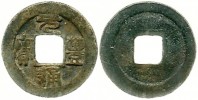
Hartill 16.212, Schjoth 545Northern Song Dynasty: Emperor Shen Zong (1068-1085), Reign Title Yuan Feng (1078-1085)
1 cash (cast bronze), 3.41 g., 24.15 mm.
Obv: Yuan Feng tong bao (seal script; small characters)
Rev: Blank
Hartill rarity 15
ex Forvm Ancient CoinsStkp
|
|
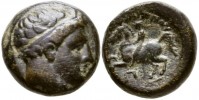
Macedonian Kingdom. Philip II (359-336 B.C.)Sear 6697-6699 var.; SNG ANS 841 ff., SNG Copenhagen 581 ff.
AE unit, uncertain Macedonian mint, 7.12 g., 16.45 min. max., 0°
Obv.: Diademed head of Apollo right.
Rev.: Youth on horseback riding left, ΦIΛIΠΠOY above, symbol below.
The obverse features the head of Apollo, who became the tutelary deity of Philip in 353 B.C. during the Third Sacred War. Vowing he would fight on behalf of the god, whose sacred treasury at Delphi had been stolen, precipitating the conflict, he used the war as an opportunity to expand his control in Greece. The rider on the reverse, similar to the reverse of his tetradrachms, ostensibly extols his victory in the horse race at the Olympic Games in 356 B.C. However, the reverse also recalls the earlier Macedonian royal types, possibly an attempt to emphasize his Macedonian ancestry. Stkp
|
|
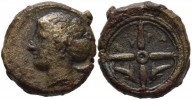
Sicily, SyracuseSear 1186, CNS 20-22; SNG ANS 404-410.
AE hemilitron, struck ca. 405 B.C., either under the Second Democracy (466-405 B.C.) or during the reign of Dionysos I (405-367 B.C.), 4.09 g., 17.33 mm. max. (including spur), 15.94 mm. max. (excluding spur), 180°.
Obv.: Head of nymph left, wearing ampyx and sphendone; dolphin behind.
Rev: Wheel of four spokes, SY-PA in upper quarters, dolphins in lower quarters.
Coins of this issue included dies signed by the masters Kimon (KIM), Phrygillos (ΦPI), Eukleidas (EY) and possibly Eumenes (E).Stkp
|
|
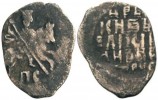
Russia. Ivan IV Vasilyevich, The Terrible (1530-1584)Grishin-Kleishnikov 77 (Knight die 5, text die 5), Group V; Melnikova 1-19/23
AR wire kopek; Pskov mint, struck ca. 1547, .61 g., 14.43 mm. max., 0◦
Obv: Horse rider with spear, ПС (= ПСКОВ = ПЛѢСКОВЪ [archaic] = Pskov), below.
Rev: Cyrillic legend in five lines, ЦРЬ[И] / КНSЬ[В] / ЕЛIКII[В] / AНЬВС[Е] / IAРУС[И] (Czar and Grand Duke Ivan of all Russia).Stkp
|
|

Beth El Talmud Torah of Flatbush (Brooklyn, New York)AE token, 32 mm., 10.96 g. (holed, probably as minted)
Obv: BETH EL TALMUD TORAH OF FLATBUSH around rim, GOD / WILL HELP beneath American flag, GREEN DUCK CO., CHI. in small letters around rim.
Rev.: 2131 EAST THIRTEENTH --BROOKLYN, N.Y. around rim, LOSE NOT / THIS LUCKY PIECE / AND THY FORTUNE / WILL INCREASE beneath Jewish star within horseshoe.
Ref.: None known.
No information available.
The Green Duck Company was founded by Greeburg and Duckheisel in Chicago in 1906 and remained there until it relocated to Mississippi in 1962, closing in 2004.Stkp
|
|

Elymais. Arsacid dynasty. Orodes III (2nd century A.D.)van't Haaff 16.3.2-1_; De Morgan 27; BMC plate XL, 1-5; Sear GICV 5895; Alram --
AE drachm, 2.66 g., 15.81 mm. max., 0°
Obv: Slender bust facing left, wearing tiara with anchor and dotted rim, diadem band below tiara, ribbon falling behind bust from dot; to right pellet within crescent above anchor with one crossbar at top; pellet border.
Rev: Anchor in field of irregular, perpendicular V-shaped and inverted T-shaped marks; no border.Stkp
|
|
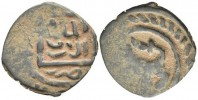
Mamluk (Bahri). Sha`ban II (al-Ashraf Nasir al-Din Sha`ban) (764-778 A.H. = 1363-1377 A.D.)Balog 464 Plate XVII 464a-b; SNAT Hamah 595-604; SICA v. VI 1319; Album 958
AE fals, Hamah mint, struck 773 A.H. = 1371/2 A.D.: 1.40 g., 18.28 mm. max., 180°
Obv.: Circular line in border of dots. In it, linear square. الملك (= al-Malik) / الاشرف (= al-Ashraf) in two rows in center; بحماة (= bi Hamah) in upper segment, ضرب (= duriba/struck) in lower segments.
Rev.: Border comprised of circular rigid cable to left between two linear circles. Lion passant to left, with tail curled back, knot in the middle of the tail.
Sha'ban II was a grandson of Muhammad I, being the son of one of Muhammad's sons who never held office. In 1363, the senior Mamluk emirs, led by Emir Yalbugha, deposed Sultan Muhammad II on charges of illicit behavior and installed ten-year-old Sha'ban as his figurehead replacement. In 1366 Sha'ban, who sought to wield power, supported a successful revolt against Yalbugha. One year later, Sha'ban, who still had few mamluks of his own but was supported by the common people, quelled a rebellion. Again in 1373, the commoners assisted Sha'ban in defeating a rebellion. Because of their loyalty and key support during these revolts, Sha'ban treated the commoners well throughout his reign, including efforts to provide food for the poor during a two-year famine in Egypt. In 1376, Sha'ban went on the Hajj pilgrimage to Mecca. In his absence emirs again rebelled against Sha'ban, which was followed by a rebellion of Sha'ban's own mamluk guard, who murdered him in 1377. Stkp
|
|

Huszár 584, Pohl 123-_, Unger 455_, Réthy II 128, Frynas H.27.12Hungary. Sigismund/Zsigmond of Luxembourg (1387-1437; Holy Roman Emperor 1433-1437)
AR ducat (= 1/4 denar; average fineness .181‰; average weight .22 g.); .28 g., 11.15mm. max, 270°
Obv: Patriarchal cross, L-I between arms.
Rev: Standing nimbate St. Ladislaus with halberd and globus cruciger.
The type was struck in 1427-1430 (per Huszár, Pohl, Unger, Frynas and Gyöngyössy). This privy mark is not recorded in Huszár, Pohl or Unger. It was probably struck at Lippa, now Lipova, Romania.
Huszár/Pohl rarity 4; Frynas rarity C. Stkp
|
|

Denmark. Christian VII (1766-1808) Copenhagen Type 4D, reverse/obverse die combination C458/CO455 Denmark. Christian VII (1766-1808)
Copenhagen Type 4D, reverse/obverse die combination C458/CO455 (uncommon = 20-50 coins); Hede 37, Schou 9-21, Sieg 2, Pedersen __, KM 616.1
1 Skilling, copper (11.693 g.). Copenhagen mint; immobilized date 1771, but probably minted between November 1782 and early 1783. Dies made by Johan Ephraim Bauert.
11.47 g., 28.30 mm. max., 0°
Obv.: Crowned double C7 monogram.
Rev.: 1 flanked by rosettes / SKILLING / DANSKE / K • M • / 1771 • / rosette, in six lines.
Of the 54,757,104 1771-dated 1 skilling coins minted over a period of 16 years (1771-1786), an estimated 30,000 to 50,000 exist. There are 984 known die combinations. They were minted at three mints; Altona, Copenhagen and Kongsberg. Type 4 comprises roughly 3.7% of the total.Stkp
|
|

Japan. Tokugawa Shogunate. Bunkyu Eiho (Gyoku Ho aka Ryaku Ho = Abbreviated Ho).Hartill 5.20 var.; Jones (2007) 351; KM C 6b; Zeno # 331943
4 mon (cast copper alloy; made from old 1 mon coins); cast from March 1863 (Bunkyu 3) to 1868 at the Asakusa mint (near Edo) and Kosuge mint; written by Matsudaira Yoshinga, one of the Four Wise Lords of the period; 3.74 g., 26.96 mm., 0°
Obv.: 文久永寶 Bun Kyu Ei Ho (=Eternal Treasure of the Bunkyu Era); cursive script, the bottom components of ho 寶 are simplified 宝, medium rim around hole
Rev.: Eleven nami/waves
Hartill rarity VC; In total, 891,515,631 bunkyu Eiho of all varieties were cast.Stkp
|
|
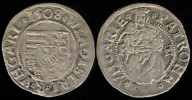
Huszár 811, Pohl 253-3, Unger 646b, Réthy II 278A, dated 1508 Hungary. Wladislaus II (Ulászló II in Hun.) (1490-1516). AR denar, 15 mm.
Obv: WLADISLAI * R * VNGARI * 1508 *, Four-part shield with Hungarian arms (Árpádian stripes, patriarchal cross, Dalmatian leopard heads, Bohemian lion), Polish eagle in escutcheon.
Rev: * PATRONA * – * VNGARIE *, Crowned Madonna with infant Jesus to her right, K–H (privy mark) in fields.
The type was struck 1503-1518 (per Huszár, Pohl & Unger) or 1490-1498 (per Unger). This privy mark was struck in Kremnitz (formerly Körmöcbánya, Hungary, now Kremnica, Slovakia) by Hans Thurzó, kammergraf, (per Pohl).
Huszár rarity rating 4/Pohl rarity rating 5.Stkp
|
|

Possibly Elymais. Arsacid dynasty. Osroes (1st quarter of 2nd century A.D.). Probably Parthia. Osroes I (109-129 A.D.).van't Haaff 15.3.1-1; de Morgan --; BMC -- Sear GICV --; Alram --
AE (Elymaean) obol or (Parthian) chalkous, 1.91 g., 12.22 mm. max., 0°
Obv: Bust facing left, with long beard and hair dressed in Parthian fashion, with a large tuft behind the face extending to the back of the head, topped by a large tuft bound with a diadem, its tips streaming behind; pellet border.
Rev: Diademed female bust (Tyche, if a Parthian emission) right; possible traces of inscription (date) to right; no border.
Van't Haaff recognized that "the attribution of Type 15 coins has been controversial" and notes that de Morgan, Le Rider and Alram have posited that they are issues of Osroes I of Parthia. Hoover agrees with these scholars, "[d]espite their appearance in the French excavations of Susa." He notes a stylistic affinity between them and Sellwood Type 80. This coin apparently appeared in association with Elymaean bronze coins in a commercial hoard, and not in the French excavations referred to by Hoover. Bell retains these emissions in the Elymaean series, but questions whether there was a separate Elymaean king Osroes. Rezakhani tentatively concludes that the Elymaean and Parthian Osroes are in fact the same person.
Attribution assistance courtesy of Robert L3 (http://www.forumancientcoins.com/board/index.php?topic=112957.0;topicseen).Stkp
|
|

Anonymous 12th Century Class I. Huszár 94; Toth-Kiss 18.8.1.1 sigla h1.1/57; Unger 38 var.; Réthy I 78; Frynas H.10.4; Lengyel 10/10; Adamovszky A82Anonymous 12th Century Class I; attributed to István/Stephen II (1116-1131) by Lengyel and tentatively attributed to him by Unger, Frynas and Adamovszky , but this attribution is not accepted by Huszár, Toth-Kiss and Gyöngyössy.
AR denar (average: .37 g., 11.5-12.0 mm.), .24 g., 11.30 mm. max.
Obv: Cross with four pellets, four crescents and four small crosses between arms.
Rev: Lines instead of an inscription, cross with four wedges.
Struck in Esztergom.
Huszár rarity 8, Toth-Kiss rarity 30, Unger rarity 25, Frynas rarity N.Stkp
|
|

Elymais. Arsacid dynasty. Orodes II (early-mid 2nd century A.D.)van't Haaff 13.2.1-2B; De Morgan 44-45, BMC plate XL, 10; Sear GICV 5904; Alram 478
AE drachm, 3.66 g., 16.40 mm. max., 180°
Obv: Bust facing forward, with no large hair tufts at sides, wearing tiara with central vertical line and dots at rim, diadem band below tiara; to right dot within crescent above anchor with one crossbar at top; pellet border.
Rev: Small radiate bust of Belos facing forward with no facial features, with hair tufts on sides and two horns; Aramaic legend URUD MALKA BARI URUD (= King Orodes, Son of Orodes) reading counter clockwise; pellet border.Stkp
|
|

Hungary. Kálmán/Coloman the Bookish (1095-1116). Huszár 33; Toth-Kiss 11.3 sigla c1.6/26; Unger 27; Réthy I 41; Frynas H.9.4; Lengyel 9/3; Adamovszky A46; Kovács pp. 168 ffHungary. Kálmán/Coloman the Bookish (1095-1116)
AR denar (average .50 g., 13.5-14 mm.), .40 g., 14.19 mm. max., 0°
Obv: + CALMAN RE (with a retrograde N), four small crosses around a central point.
Rev: LADLAV RE (decaying legend), cross with wedges.
Struck in Esztergom. Struck ca. 1097-1105 (per Gyöngyössy, whose dating has not been accepted by later catalogers and appears to be speculative). Hóman hypothesized that the chronology of Coloman’s coinage can be determined via the progressively diminishing average weights of the emissions. By this hypothesis, this emission is ranked 2/15, and was struck at the beginning of Coloman’s reign.
Huszár rarity R1, Toth-Kiss rarity 50, Unger rarity 50 DM, Frynas rarity N.
Ladislaus/László I (1077-1095) was canonized in 1192. His name typically appeared, albeit in an increasingly decaying form, on the reverse of 12th century emissions such as this.Stkp
|
|

Judaea. Alexander Jannaeus (103-76 B.C.)Hendin 473, TJC Group P, AJC I Group E
AE Prutah, 13 mm.
Obv: Paleo-Hebrew legend in five lines in a wreath:
יהו/נתן הכ/הן הגדל/וחבר הי/הידם
(YHWNTN HKHN HGDL WHBR HYHWDYM = Yehonatan the high priest and the council of the Jews)
Rev: Double cornucopia with pomegranate in between the horns.
Stkp
|
|

Vietnam. Later Lê Dynasty. Lê Nhán Tông (1443-1459). Thái Hòa Thông BảoBarker 32.12; Toda 54 var; Zeno # 256218
Bronze 1 van; cast during first nien-hao (1443-1453); 22.99 g., 24.36 mm.
Obv: 大和通寶 Thái Hòa Thông Bảo
Rev: plain
Central Style variety; 和 Hòa to the left.
The character 太 Thái in the legend is written with the character 大 Đąi.
Barker rarity 7Stkp
|
|
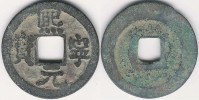
Hartill 16.170, Schjoth 527Northern Song Dynasty: Emperor Shenzong (1068-1085), Reign Title Xining (1068-1077).
1 cash (cast bronze), 24 mm.
Obv: Xi ning yuan bao (seal script, ning written with a curved stroke at the bottom).
Rev: Blank.
Hartill rarity 15.Stkp
|
|
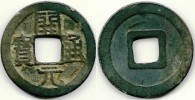
Hartill 14.4 Schjoth 312 ffTang Dynasty: Kai Yuan (Middle Type, 718-732)
1 cash (cast bronze), 3.57 g., 24.50 mm.
Obv: Kai Yuan tong bao (left shoulder Yuan)
Rev: Blank
The Kai Yuan was the main coin issued by the Tang. It was cast for most of the dynasty, nearly 300 years. It was first issued by the Emperor Gao Zu in the Autumn of the fourth year of the Wu De Period (August 621). The inscription Kai Yuan tong bao (the Inaugural Currency) is the first to include the phrase tong bao. The Kai Yuan became the prototype for subsequent Chinese coinage.
Hartill rarity 13
ex Forvm Ancient Coins
Stkp
|
|

Anonymous 12th Century Class I. Huszár 80; Toth-Kiss 18.1.1 sigla 0.1/1; Unger 59 var.; Réthy I 67; Frynas H.12.6; Lengyel 10/14; Adamovszky A113Anonymous 12th Century Class I. Attributed to István/Stephen II (1116-1131) by Lengyel and tentatively attributed to Geza II (1141-1162) by Unger, Frynas and Adamovszky, but these attributions are not accepted by Huszár, Toth-Kiss and Gyöngyössy.
AR denar (average: .20 g., 10.0-10.5 mm.), .16 g., 9.98 mm. max.
Obv: S and retrograde S on either side of a T-figure.
Rev: Three lines and three crescents instead of an inscription, cross with four pellets.
Struck in Esztergom.
Huszár rarity 5, Toth-Kiss rarity 40, Unger rarity 36, Frynas rarity N.Stkp
|
|

Hungary. Venzel/Wenceslaus Premyslid (1301-1305). Huszár 433, Toth-Kiss 26.1.1.1, Unger 342, Réthy I 382, Frynas H.22.1, Lengyel 22/1, Adamovszky A529Hungary. Venzel/Wenceslaus Premyslid (1301-1305)
AR denár (average .66 g., 15.5-16.0 mm.); .39 g., 11.47 mm. max., 270°
Obv: Crowned horseman riding right holding a sword.
Rev: Eagle standing left.
Huszár rarity R1, Toth-Kiss rarity 100, Unger rarity 36, Frynas rarity S.
ex Allen G. Berman; ex Gordon Andreas Singer; ex Alex G. Malloy, Inc. Auction Sale Catalog XIX (March 16, 1984), Lot 972; ex St. George Tucker Collection (see discussion at http://www.forumancientcoins.com/board/index.php?topic=118005.msg715272#msg715272 re my efforts to provenance the coin, thanks to the assistance of Jordan Montgomery).Stkp
|
|

Hebrew Kindergarten & Infants Home (New York , N.Y. & Far Rockaway, Queens County, N.Y.)AE token, 32.5 mm., undated.
Obv: HEBREW KINDERGARTEN & INFANTS HOME and 35 & 37 MONTGOMERY ST. N.Y.C./CENTRAL & PLAINVIEW AVES. FAR ROCKAWAY, along toothed rim, bust of boy facing within laureate wreath in center.
Rev: HAVE A HEART/HELP THE/ORPHANS/ -- AND --/GOD WILL/HELP YOU, within laureate wreath, GOOD LUCK COIN along toothed rim, beneath.
Ref: Kaplan, Steven H.. “Great Appeal, Kindergarten Tokens Asked for Support,” The Shekel, XLIV No. 1 (January-February 2011) 49-53, Figure 2 (this token).
Note: The Hebrew Kindergarten and Day Nursery Association was established in 1905 at 29 Montgomery Street as a nursery for the care of children of working mothers. It purchased 35 and 37 Montgomery Street in 1913 for the construction of a three-story building, which was dedicated in May 1914. In November 1918, it opened a ward for children whose mothers had influenza, and also began to care for children whose mothers had died during the epidemic. By then, there had already been a fund drive in August 1918 to raise $50,000 for an orphanage at Far Rockaway, and another fund drive, to raise $100,000 for the completion of its new building. It was then known as the Hebrew Kindergarten, Day and Night Nursery. It formally changed its name to Hebrew Kindergarten & Infants Home, Inc. in August 1925, although it was apparently using that name as early as 1923. Its infant home in Far Rockaway was at the intersection of Plainview Avenue and Central Avenue/Beach 20th Street, and an address of both 310 Central Avenue and 310 Beach 20th Street. It still operates an early childhood program/day care program for ages pre-kindergarten through kindergarten on a nonsectarian basis at that location.
Note: Three different fundraising tokens were issued, all of which contain the address of the day school on Montgomery Street as well as the addresses of the orphanage on Plainview Avenue and Central Avenue, in Far Rockaway. The most common of the three tokens was apparently issued in connection with the August 1923 fund drive for the completion of that building, and this token was apparently issued at a later date in connection with a lesser fund drive.Stkp
|
|

Korea. Yi Dynasty. Sang Pyong Tong Bao. Pyongan Kamyong/Pyongan Provincial Office Mandel/Velde-Hartill 47.4.2; KM 917.2; Zeno # 259678
AE 1 mun; cast 1883 or 1892 by the Pyongan Kamyong/Pyongan Provincial Office (Anju, Pyongan Province); second series; 3.13 g., 23.25 mm.
Obv: 常平通寶 Sang Pyong Tong Bao
Rev: 平 Pyong above; 二 O/2 below; circle to left
Two-dot 通 tong, hooks in 平 Pyong on obverse
Velde-Hartill rarity: Very CommonStkp
|
|

Germany. Hans Krauwinckel II, rose/orb groupMitchener 1534-1539; Neumann 32241
Jeton/Rechenpfennig minted by Hans Krauwinckel II (active 1586-1635) in Nuremberg, brass; 21.65 mm. max., 0°
Obv.: ⁕ HANNS • KRAVWINCKEL • IN • NVR (=Hans Krauwinckel in Nuremberg), Three crowns, alternately with three lis, arranged around a central rose.
Rev.: ⁕ GOTTES • GABEN • SOL • MAN LOB (=One should praise God’s gifts), Imperial orb within a double tressure of three arches and three angles.Stkp
|
|

Hungary. Anonymous 12th Century Class III. Huszár 159; Toth-Kiss 20.13.1.1 sigla b1.7/29; Unger 60; Réthy I 149; Frynas H.12.7; Lengyel 12/4; Adamovszky A143.Hungary. Anonymous 12th Century Class III; attributed to Géza II (1141-1162) by Lengyel and Adamovsky, and tentatively attributed to him by Unger and Frynas, but this attribution is not accepted by Huszár, Toth-Kiss and Gyöngyössy.
AR denar (average: .32 g., 13 mm.), .16 g., 11.75 mm. max. (clipped).
Obv: Cross with crosses at the end of each arm, bar between two crescents in each angle
Rev: Cross with pellets in the angles.
Huszár rarity R1, Toth-Kiss rarity 100, Unger value 75 DM, Frynas rarity S.Stkp
|
|

Cilician Armenia. Gosdantin/Constantine I (1298-1299)Nercessian 417-18 var., Bedoukian 1730
AE kardez. Sis (now Kozan, Turkey) mint. 1.99 g., 20.18 mm. max., 0°
Obv: King standing, facing, wearing royal vestments, holding cross in left hand and sword in right hand, +ԿՈՍՏԱՆԴ -- ԻԱՆՈՍ Թ[ԱԳ] with the ՈՍ ligate (= Gosdantin King).
Rev. Ornate cross with dots at ends of three of the arms, ՇԻՆԵԼ Գ[ԱՂ]ԱԳՆ ՍԻՍ Է (Shineal I Kaghakn I Sis = Struck in the City of Sis).
Nercessian rarity for type 7R/rare (less than 62 known)
Gosdantin was one of the sons of Levon/Leo II (1270-1289). In 1296 his brother, King Hetoum II (1289-1303) placed Armenia under the regency of their brother Smpad, and traveled to Constantinople for the wedding of their sister to the Byzantine Emperor Michael IX Palaeologus. During his absence Smpad (1296-1298) usurped the throne with the aid of Gosdantin. Hetoum was imprisoned upon his return and was partially blinded. Gosdantin then turned against Smpad, usurped the throne for himself, imprisoned Smpad and freed Hetoum. In 1299, Hetoum ousted Gosdantin and again resumed the crown. Smpad and Gosdantin were imprisoned for the rest of their lives. Gosdantin ruled for less than a year.Stkp
|
|
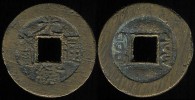
Schjöth ----, Hartill (QC) 5.291 Type A1 & (CCC) 22.1276, KM C1-16Guangxu (1875-1908)
1 cash (cast brass), 1887-1899 [?], Board of Revenue mint (in Beijing), south branch, 22 mm.
Obv: Guangxu tongbao.
Rev: Boo chiowan.
Type A1 is comprised of larger coins with a diameter over 20 mm., an actual weight over 3 grams, and a nominal weight of 1 qian (= 3.73 grams). The coins issued by the south branch of the Board of Revenue mint have square head, two dot tong.
Hartill (QC) rarity 9 and (CCC) 15.Stkp
|
|

Géza II (1141-1162). Huszár 55; Toth-Kiss 14.1 sigla a1.--/--; Unger 54; Réthy I 63; Frynas H.12.1; Lengyel 12/1; Adamovszky A111.Géza II (1141-1162)
AR denár (average: .35 g., 12-13.5 mm.), .32 g., 12.75 mm. max., 180°
Obv: +C-EI-SA-RE, Long cross with pellets in each angle, lines connecting the arms, small crosses at ends of arms.
Rev: Lines and crescents instead of an inscription, cross with pellets in the angles.
Huszár rarity 9, Toth-Kiss rarity 50, Unger rarity 38, Frynas rarity N. Unrecorded sigle. Stkp
|
|

Huszár 598, Pohl 135--, Unger 469-, Réthy II 149A Hungary. Wladislaus I (Ulászló in Hun.) (1440-1444). Billon denar, 13 mm.
Obv: [M • WLAD]IS–LAI • REGI[S], Patriarchal cross, retrograde A–n (privy mark) in fields.
Rev: Central cross surrounded by three shields bearing (in clockwise order) Lithuanian rider, Árpádian stripes and Polish eagle, all within border.
The type was struck in 1440 (per Huszár) or 1440-1441 (per Pohl & Unger). This privy mark was struck in Alsólendva, Hungary (now Lendava, Slovenia), and is listed in Huszár, but not in Pohl or Unger.
Huszár/Pohl rarity rating 4.
Stkp
|
|

Huszár 722var., Pohl 223-2var., Unger 567cvar., Réthy II 232var., Kaplan Subtype B Hungary. Matthias "Corvinus" (Mátyás Hunyadi in Hun.) (1458-1490). AR denar, 16 mm.
Obv: + M • MATHIE • R • VNGARIE •, Four-part shield with Hungarian arms (Árpádian stripes, patriarchal cross, Dalmatian leopard heads, Bohemian lion), raven with ring in escutcheon.
Rev: PATRON — VNGARIE, Crowned Madonna with nimbate infant Jesus to her right, K—P/thin rosette (privy mark) in fields.
The type was struck in 1487-1490 (per Pohl) or 1489-1490 (per Huszár & Unger), with an average fineness of approximately .500 silver, and an average weight of .59023 g. This privy mark was struck in Kremnitz (formerly Körmöcbánya, Hungary, now Kremnica, Slovakia) by Peter Schaider, oberkammergraf (per Pohl), in 1489 (per Pohl).
Huszár/Pohl rarity rating 4. This type has three subtypes. Subtype B comprises around 30% of the coins of this emission. This coin is unusual in that the Madonna is not nimbate.
Subtype B coins do not have pellets or annulets to the sides of the shield. It is depicted in Huszár.
Stkp
|
|

Denmark. Christian VII (1766-1808). Altona Type 7F, reverse/obverse die combination A775/AO774 Altona Type 7F, reverse/obverse die combination A775/AO774 (common = 50-100 coins); Hede 37, Schou 9-21, Sieg 2, Pedersen __, KM 616.1
1 Skilling, copper (11.693 g.). Altona mint (in Royal Holstein-Schleswig); immobilized date 1771 but minted from mid-1784 to July 1785. Dies made by Johan Henrik Wolff.
11.65 g., 30.48 mm. max., 0°
Obv.: Crowned double C7 monogram.
Rev.: 1 flanked by rosettes / SKILLING / DANSKE / K • M • / 1771 • / rosette, in six lines.
Of the 54,757,104 1771-dated 1 skilling coins minted over a period of 16 years (1771-1786), an estimated 30,000 to 50,000 exist. There are 987 known die combinations. They were minted at three mints. Altona Type 7 comprises 22.1% of the total.Stkp
|
|

Hungary. Béla IV (1235-1270). Huszár 314; Toth-Kiss 22.43.1.1; Unger 236; Réthy I 247; Frynas H.18.24; Lengyel 18/51; Adamovszky 376Hungary. Béla IV (1235-1270)
AR obulus (average .24 g., 9.9 mm.); .24 g., 9.42 mm. max. 90°
Obv: • + REX [• B]ELA [•], Crowned bust facing front.
Rev: Eagle with spread wings
The corresponding denár (Huszár 314) was struck after the Mongol invasion of 1241-1242 per Gyöngyössy.
The corresponding denár bears a symbol immediately following the legend which is described as a retrograde letter K in Huszár, Adamovszky and Gyöngyössy. It was identified as the Hebrew letter ×—/het by Rádóczy and Nagy, and is probably the mark of Henok. The symbol is identified as the Hebrew letter צ/tsadi by Toth-Kiss and as the letter מ/mem by Lengyel. The symbol is not depicted in or specifically stated to be present on the obolus by Huszár, Unger, Réthy and Frynas, although it is both depicted and stated to be present by Adamovszky. If ever present on the obulus, it is present on a minority of coins. It does not appear on this coin.
The coins of Béla IV were issued with an average fineness of .800 and “later” .900, per Huszár at 11.
Huszár rarity 8; Toth-Kiss rarity 35; Unger value 60 DM; Frynas rarity SStkp
|
|
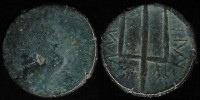
Thrace, Celtic, Bastarnae TribeAE 18 mm., struck ca. 220-160 B.C.
Obv: Crude head of the river-god Strymon facing right.
Rev: Trident with pseudo-legend.
Note: The Bastarnae were of uncertain, but probably mixed Germanic-Celtic-Sarmatian, ethnic origin, and lived between the Danube and the Dnieper during the last centuries B.C. and early centuries A.D. This coins is imitative of the Macedonian issues of Philip V of Macedon (221-179 B.C.), SNG Cop. 1299.Stkp
|
|
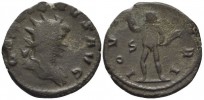
Gallienus (Publius Licinius Egnatius Gallienus) (253-268 A.D.)SRCV 10247, RIC V S-221 (Rome), Göbl 348a, Van Meter 117.
BI Antoninianus, 2.34 g., 19.12 mm. max., 0°
Rome mint, struck during solo reign (260-268 A.D.) in 260-261 A.D.
Obv: GALLIENVS AVG, radiate head right, one ribbon behind, one forward across shoulder.
Rev: IOVI [VLT]ORI, Jupiter naked standing right looking back, holding lightning bolt aloft in right hand, cloak flying right. S in left field.
The reverse dedicates this coin to Jupiter the Avenger. In 260-261 A.D., Balista, prefect of the pretorianus under Valerian, along with Odenathus, King of Palmyra, drove the Sassanian Shapur I from Syria into Persia, and re-established Roman power in the East.
RIC rarity C, Van Meter VB1.Stkp
|
|

Troas. BirytisSear 4058; SNG Copenhagen 250; SNG München 19 170; BMC Troas p. 40, 6-7
AE 11, struck ca. 300 B.C., 11.57 mm. max, 1.26 g, 0°
Obv.: Head of bearded Kabeiros left, wearing pileus.
Rev.: B-I / P-Y in fields at sides of club, all within laurel wreath.
Birytis' precise location in the Troad remains unknown. Numismatics provides our only evidence this city existed.
The god Kabeiros is similar in appearance to Dionysos and the rites of his cult were likely similar to those of the Dionysian mysteries.Stkp
|
|

Huszár 733, Pohl 228, Unger --, Réthy II 248, Frynas S. Wroc. 10.1, Kopicki 8774-8775, Friedensburg 557bHungary. Matthias/Mátyás Hunyadi ("Corvinus") (1458-1490), as King of Bohemia (1469-1490).
AR garas/groschen, struck for the city of Wratislawia in Silesian Bohemia (now Breslau/Wroclaw, Poland); 2.12 g., 25.90 mm. max., 180°.
Obv: + MATHIAS • PRIMVS • D • G • R • BOHEMIE, Four-part shield with Árpádian stripes, Bohemians lion, Lusatian bull and Silesian eagle, raven with ring in escutcheon.
Rev: GROSSVS • WRA-TISLAVIENSIS, Figure of Saint John the Baptist facing, holding lamb.
Type struck 1470-1490 (per Pohl) for the city of Wratislawia in Silesia (now Breslau/Wroclaw, Poland), after Matthias was elected by the insurgent Catholic Czech aristocrats as king of Bohemia in 1469 in opposition to the Hussite king, George PodÄ›brady, and seized Silesia. He was never crowned. In 1479, he agreed to limit his rule to Moravia, Silesia, and Lusatia, while retaining his title. Huszár does not list the coin without a W mintmark (in the reverse left field) but Pohl notes that it also appears without a mintmark. It seems to be more common without the mark.
Huszár/Pohl rarity 10, Frynas rarity S.Stkp
|
|

Vietnam. Nguyễn Emperors. Nguyễn Thánh Tô (1820-1840). Minh Mąng Thông BảoBarker 101.11; Toda 228 var; KM 182a var; Craig 81.2 var; Zeno # 256253
Bronze 1 van; cast 1820-1840; 2.52 g., 22.99 mm.
Obv: 明命通寶 Minh MÄ…ng Thông Bảo
Rev: plain
Small flan, large 通寶 Thông Bảo.
Barker rarity 8Stkp
|
|
| 1658 files on 19 page(s) |
 |
 |
5 |  |
 |
|

|
